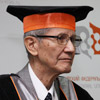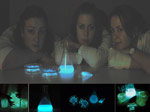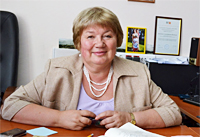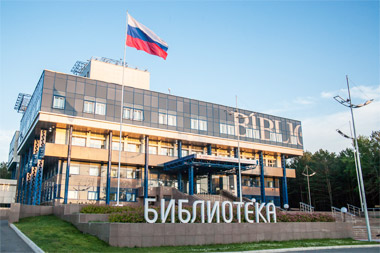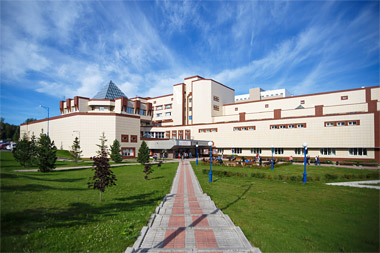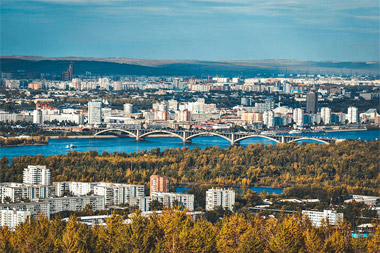Specialized English-Taught International Semester Program of Master’s Level.
International Semester Program “Bioluminescent Biotechnologies” offered by Siberian Federal University (School of Fundamental Biology and Biotechnology) constitutes a Special English-taught Module of Master in Biophysics. The Program is aimed at students having background in natural science and wishing to master contemporary methodology of scientific research in order to pursue career in the field of biological engineering.
Training
The major part of the Program’s training takes place at the modern and well-equipped SibFU Laboratory of Bioluminescent Biotechnologies, led by Nobel Laureate Professor Osamu Shimomura, in one of the world’s strongest team of scientists engaged in fundamental research of light emission by living organisms, i.e. bioluminescence.
«Despite the fact that many countries are doing research into the practical application of bioluminescence, fundamental chemical research in this field has ceased almost everywhere else in the world except Russia».Osamu Shimomura, Nobel Laureate in Chemistry
Research projects
While following the Program students have to deal with the phenomenon of bioluminescence in all its aspects: from genetic and molecular to evolutionary and ecological. Master’s research projects are focused on studying the chemical nature of light emission by new luminous species (fungi, soil worms, coelenterates, bacteria, etc.), modelling the enzyme behaviour in cell hyaloplasm, development of new recombinant bioluminescent organisms and of a new generation of bioluminescent biosensors for environmental monitoring and medical diagnostics as well as on other fundamental and applied topics.
Krasnoyarsk researchers have recently deciphered the structure of the luciferin of Siberian soil worms.
Who knows, maybe you will be able to unravel the mystery of glowing mushrooms?
Relevant links
Prof. Valentina KRATASYUK
Doctor of Sciences (Biology), Head of Biophysical Department, School of Fundamental Biology and Biotechnology, Siberian Federal University.
Research interests: bioluminescent biosensors, biophysics, biotechnology, biochemistry, luminous bacteria, bioluminescent analysis, enzymatic toxicity bioassays, history of biology, science education.
Training methods: lectures, lab experiments, case studies and group discussions.
Teaching staff: SibFU Professors and visiting lecturers from universities of Russia, USA, Italy, China, Spain, UK and other countries.
| Duration: | 1 semester 18 weeks (30 ECTS) |
|---|---|
| Starting date: | April, 1 |
| Language: | English |
| Entry requirements: |
|
| Application deadline: | November, 25 |
| Tuition fee (per semester): | 125,000 rubles |
| Accommodation: | On-campus accommodation is available in double and triple-occupancy rooms (€ 20 per month). |
| Practicalities: | Airport transfer, invitation letter for a Russian study visa and an optional survival course of Russian as a foreign language are provided by the University. |
| Course Title | ECTS |
|---|---|
Compulsory course: Contemporary issues of biophysics
Objectives and learning outcomesThe course focuses on the application of contemporary concepts and methodology of physical sciences to the solution of biological problems. Students completing the course shall be able to:
ContentsThis course is designed to provide students with the knowledge, skills and analytical capabilities needed to reflect on and discuss key problems of biology: biological evolution, origin of life, key characteristics of life as a phenomenon, principles of living beings organization; structure-function relationship in living systems. During the course practical seminars will be offered which will allow the students to apply modern theoretical and experimental approaches in order to research biological systems at molecular, cellular and other levels. Course components
During classes all information is given in an interactive form with the use of various handouts. Focus on reflection and discussion. Short assignments for doing in class or as homework. Assessment60% written exam, 40% class participation. Core readingExtensive course manual compiled by professors of the Biophysical Department of the Siberian Federal University (Valentina Kratasyuk, Irina Sviderskaya, Irina Siukovataya et al). The manual includes detailed course program, guidelines for seminars and self-study, various thematic materials, including lecture handouts, PowerPoint presentations as well as other additional materials required to complete the assignments. | 4 |
Compulsory course: Physics and chemistry of bioluminescence
Objectives and learning outcomesThe course focuses on exploring basic and applied aspects of bioluminescence. After successfully completing the course students:
ContentsSpecific topics covered in the course include:
Course components
Assessment60% test, 40% class participation Core reading
| 3 |
Compulsory course: Bioluminescent Biotechnologies
Objectives and learning outcomesThe objective of the course is to enable students to build up their knowledge and skills pertaining to the use of living organisms for solving real-world problems related to the life sciences. Students will be encouraged to develop their own engineering solutions by means of analytical, synthetic or combined methods. After completing the course students should be able to apply the principles of biology and engineering tools in order to create tangible bioluminescent products to be used in real-world situations. ContentsThe course begins with an outline of major trends in biological engineering focusing students’ attention on the following topics: biosensors and biochips as a part of the huge and rapidly evolving areas of biomolecular and bioanalytical sciences. The subsequent chapters of the course concentrate on the various aspects of biosensors design: biological and molecular recognitions systems, transducers for biosensors and bio-array technologies, miniaturized and micro-engineered systems. Special emphasis will be made on current methods of enzymes immobilization and applications of immobilized enzymes for medical diagnostics, environmental monitoring, pharmaceutical and food industries. Course components
During classes all information is given in an interactive form with the use of handouts. Focus on reflection and discussion. Short assignments for doing in class or as homework. Assessment60% test, 40% class participation. Core reading
| 4 |
Compulsory course: Photobiophysics
Objectives and learning outcomesThrough this course students will obtain knowledge about the main principles of photobiophysics and all aspects of photoreactions: from the elementary phenomena and laws, through reactions and apparatus review to practical aspects of photochemistry, photobiology. Students will also learn about and acquire the ability to interpret different aspects of photobiophysics in the natural environment. Contents
Course components
During classes all information is given in an interactive form with the use of handouts. Focus on reflection and discussion. Short assignments for doing in class or as homework. Assessment60% exam, 40% class participation. Core readingTeam of scientists led by Professor Valentina Kratasyuk (program leader of Master in Biophysics) has developed a special training kit for this course, which besides detailed methodological guidelines and presentation materials includes a DVD with a set of training tests.
| 3 |
Elective course: Laboratory training course: mechanisms and applications of bioluminescence
Objectives and learning outcomesThe practicum provides an opportunity to master main techniques for measuring bioluminescence in vitro and learn to apply them in such fields as environmental monitoring, medical diagnostics, pharmaceutical and food industries. The course also allows students to investigate the fundamental principles of physics, chemistry and biology using the phenomenon of bioluminescence, which serves an important tool for science education as it help to visualize many biological and physical processes. After completing the course students should be able to:
ContentsThe course is built up around three main topics: principles of bioluminescent assays, media effects on bioluminescence efficiency and application of bioluminescence in teaching biochemistry. During the course students will execute a number of laboratory tasks that envisage performance of various bioluminescent reactions related to the abovementioned topics. On the basis of one selected task an individual research project is to be developed by each student. Several examples of laboratory tasks:
Course components
AssessmentCombination of written exam (40%) and project (60%). Core readingFor students following the course there is a special set of materials available which is prepared by biophysics scientists from the Siberian Federal University as well as the Research Institute of Biophysics (Siberian Branch, Russian Academy of Science). The said educational materials are based upon original research of the authors. | 3 |
| Elective course: Contemporary problems of ecology | 3 |
Elective course: Writing and presenting science
Objectives and learning outcomesThis course is intended for ESL students. The course aims to teach the fundamentals of effective scientific communication in English. Instruction will focus primarily on the process of writing original manuscripts for professional journals and presenting research results at conferences. ContentsThe course will be presented in segments: structure, vocabulary and grammar of scientific papers, scientific English, oral and visual presentations. Science writing as a story telling. Paper structure: IMRAD and other formats. Writing introduction, methods, results, discussion and conclusion. Challenge, hypothesis, objective. Scientific English (words, sentences, paragraphs). Tables and figures. Writing global science. Abstracts. Preparing slides, text and speech for presentations. Course components
AssessmentCombination of written exam (50%) and project (50%). | 3 |
Elective course: Governance of ecosystem services
Objectives and learning outcomesThe aim of the course is to develop an understanding of ecosystem services and their role in development of different territories and to learn how to transfer the techniques of ecosystem services assessment into policy-making process. By the end of the course successful students should acquire the concept of “ecosystem services”, their classification and environmental and economic values, and be able to:
ContentsThis interdisciplinary course aims to introduce students to new instruments of nature conservation and is based on three pillars: 1) Ecosystem Science – studying various ecosystems, their components and elements; 2) Economics – using economic methods of assessment of ecosystem services; and 3) Political Science – applying planning and management instruments in decision-making process. Emphasis will be placed on implementation of new concepts and instruments to the ecosystems governance. In addition, the course includes sessions with practical exercises on assessment methods, demonstrating good and bad practices. The course also gives a perspective on broader international context of ecosystem services by engaging students into analysis of real cases from Russia, Ukraine and other countries. Course components
Assessment60% exam, 40% class participation. Core readingCourse manual and additional materials. | 3 |
Research skills lab
Objectives and learning outcomesPractical skills and techniques development, introduction to new research methods, and application of the obtained skills during the experimental work on the modern equipment. After completing the course student will be able to design and present professionally research and experimental results. Contents
Course components
Assessment
Core readingOriginal materials prepared under the guidance of the head of the master's program V.A. Kratasyuk, including instructions and technical specifications. | 5 |
Master`s research project
Objectives and learning outcomesThis course aims to encourage research skills by students through an individual research project in biology, biological engineering or biophysics. Students will follow all steps of research process from the problem statement to the achievement and analysis of experimental results. Contents
Course components
AssessmentDefense of the master’s research project (draft master’s thesis). | 5 |
| Program Total | 30 |
More information?
Please contact our Department of International Educational Programs, SibFU
e-mail: study [at] sfu-kras [dot] ru
phone: +7 391 206-39-28
fax: +7 391 206-21-66
address: 82/6 Svobodny pr., room 427, Krasnoyarsk, 660041 Russia
 VKontakte: vk.com/international_education_sibfu
VKontakte: vk.com/international_education_sibfu
Ask a question
The University
Today Siberian Federal University (SibFU) with over 35,000 students enrolled in its programmes is one of the most actively developing universities in Russia. Annually more than 200 visiting professors — leading scientists from UK, Germany, Spain and USA — deliver their lectures at SibFU.
The University is a winner of the Russian Government grants supporting research projects under the guidance of top-level scholars from Russia and all over the world.
The campus of Siberian Federal University is located in a forested area of the city of Krasnoyarsk. Academic buildings and dormitories of the university are surrounded by natural forest lands and easily accessible by the public transport. More information about the University Campus can be found here.
The City of Krasnoyarsk
Krasnoyarsk is the administrative capital of Krasnoyarsky kray — second largest region of Russia. It is a big industrial and educational centre with a population of more than 1 million people, and also an important junction of the Trans-Siberian Railway.
The city is located on the banks of the Yenisey River in the valley formed by the Eastern Sayan Mountains. Nature reserve Stolby ("pillars") has become the city’s visiting card.
Among the famous people born in Krasnoyarsk are artist Vasily Surikov, opera singer Dmitri Hvorostovsky, biathlete Evgeny Ustyugov, skeletonist Alexander Tretyakov and ice-hockey player Alexander Semin.
In March 2019 Krasnoyarsk proudly hosted the

 Siberian Federal University
Siberian Federal University 
